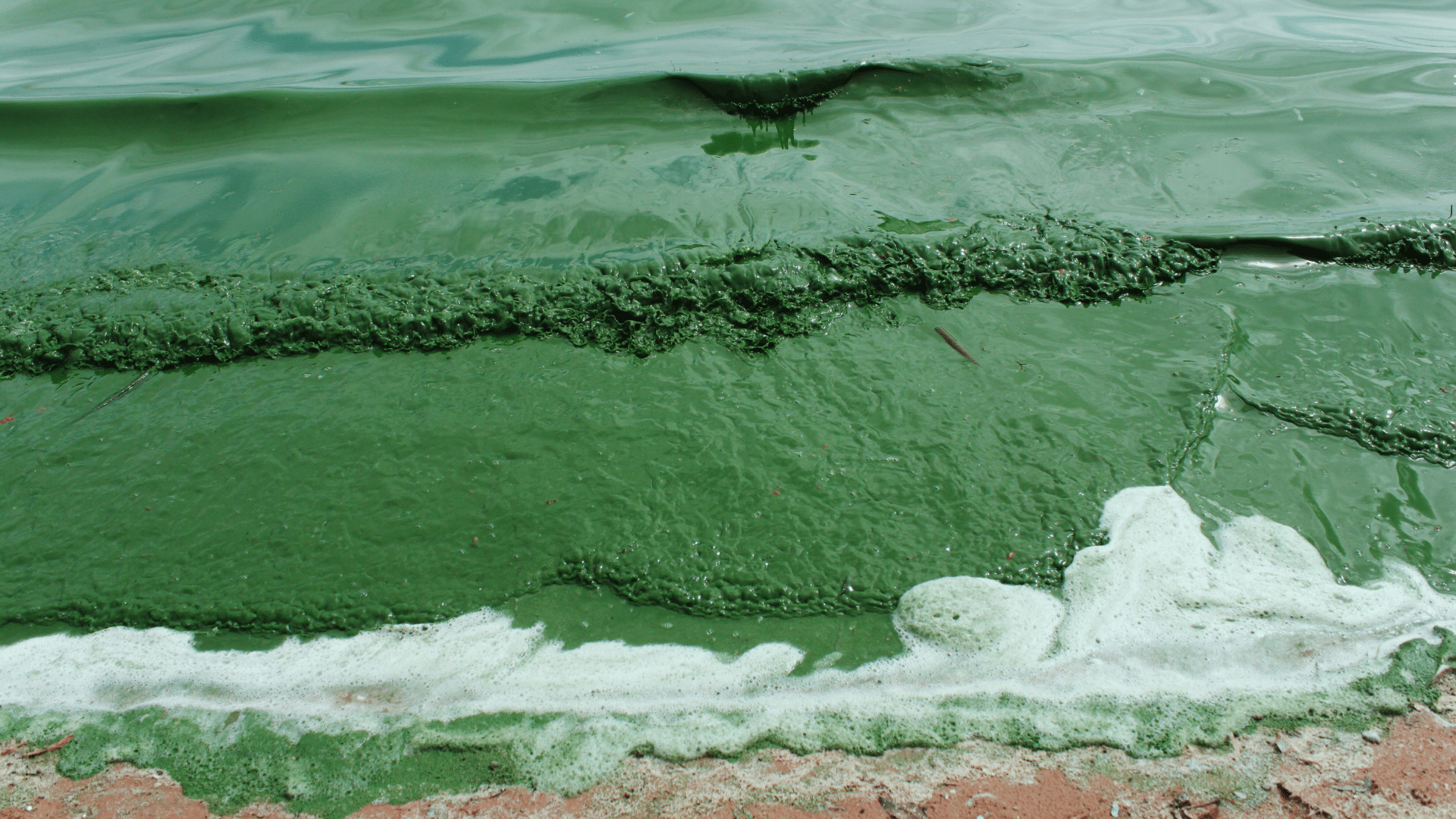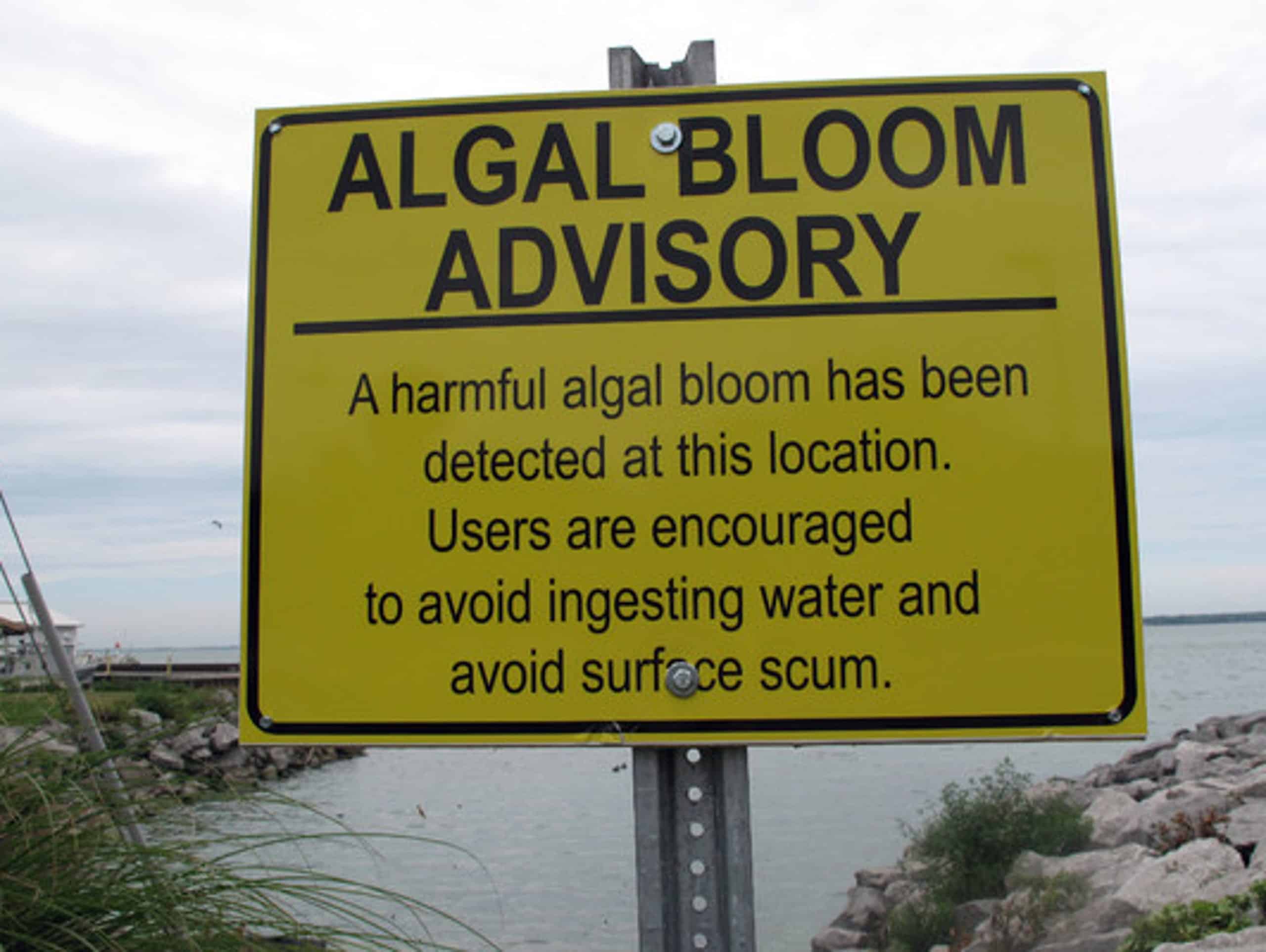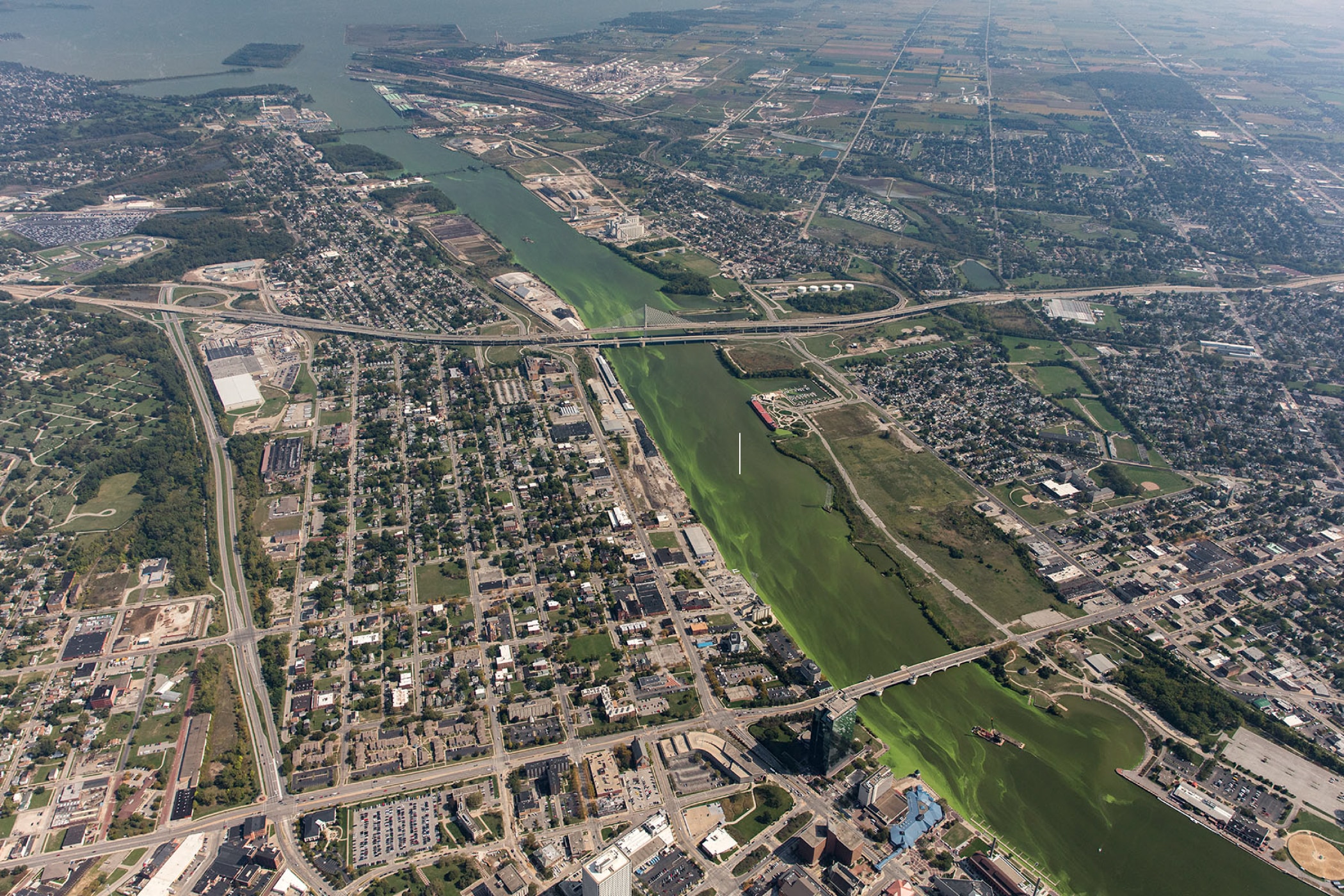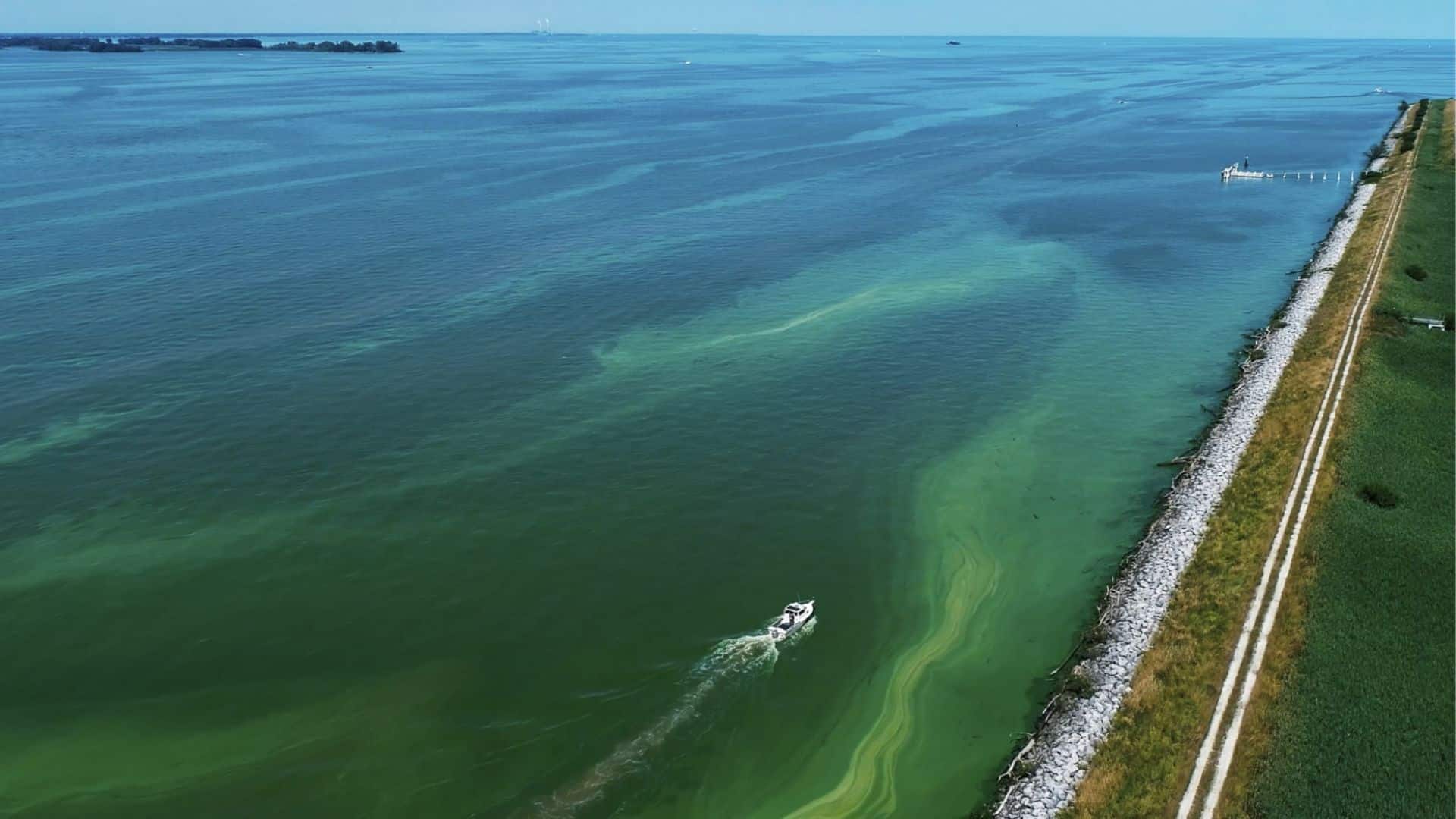A decade ago, Toledo faced an unprecedented crisis when a toxic algal bloom in Lake Erie rendered the city’s water supply undrinkable for nearly three days. This disaster, which cost Toledo an estimated $65 million, not only disrupted daily life but also eroded trust in the city’s water system.
Unfortunately, the issues that plagued Toledo are far from resolved. Over the past ten years, the intensity of harmful algal blooms in Western Lake Erie has surged, extending the problem beyond city limits to a national scale. These blooms, dominated by cyanobacteria or blue-green algae, continue to produce dangerous toxins, fouling coastlines, threatening public health, and causing significant economic disruptions for communities and businesses dependent on the lake.

Close-up view of harmful algal blooms: This dense, green layer of algae produces toxins and has multifaceted negative impacts on various aspects of the environment and society.
The National Oceanic and Atmospheric Administration (NOAA) provides forecasts and data on Lake Erie’s water quality and environmental conditions. Their latest report shows that the harmful algal blooms have intensified and are now expanding, with toxin levels in the lake exceeding recreational safety limits.

A warning sign advises Lake Erie users to avoid contact with the active algae bloom in Sandusky Bay for health reasons. Photo Credit: Brenda Culler, Ohio Department of Natural Resources
New Factor Intensifying Toxic Algal Blooms in Lake Erie Revealed
In a groundbreaking study, researchers from Lawrence Livermore National Laboratory, the University of Toledo, and the University of Michigan have uncovered a surprising new factor fueling harmful algal blooms in Lake Erie: organic nitrogen. While phosphorus and inorganic nitrogen have long been known culprits, this study reveals that organic nitrogen, found in compounds like amino acids and proteins, plays a significant role in sustaining these toxic blooms.
By employing advanced techniques such as nanoSIMS and innovative microbiome analysis, scientists have shown that the microbiome associated with Microcystis can enhance toxin production through the utilization of organic nitrogen. This research underscores the need for a deeper understanding of nutrient dynamics in freshwater systems.
Causes, Costs, and Responses: A Brief Overview
Toxic algae blooms in Lake Erie are primarily driven by nutrient pollution and further exacerbated by warm temperatures and abundant sunlight. Sources of nutrient pollution include agricultural runoff, wastewater discharge, industrial processes, and stormwater runoff. In the case of Lake Erie, metro wastewater contributes to the issue, but runoff from agricultural sources — primarily manure and fertilizer — plays the biggest role. Given that 79% of the Maumee River watershed is used for agriculture, the impact is substantial.

Agricultural runoff is water flowing over farmland, picking up soil, fertilizers, and chemicals, and carrying them into nearby water bodies.
In response to the crisis, Ohio launched the H2Ohio program in 2019, encouraging over 3,000 farmers to adopt better fertilizing practices across nearly 2 million acres. The program also focuses on creating wetlands to capture nutrients before they reach the Maumee River.

Example of a wetland: It acts as a natural filter, trapping sediments, nutrients, and pollutants from agricultural runoff with its dense vegetation and slow-moving water.
The state has poured more than $270 million into this initiative so far, but the journey to restore Lake Erie is far from over. Algal blooms persist, casting doubt on whether these efforts are enough.

View of the Maumee River, a key area impacted by agricultural runoff contributing to Lake Erie’s algal blooms. Photo credit: Aerial Associates Photography, Inc., Zachary Haslick.
The city of Toledo has invested half a billion dollars to upgrade its water treatment systems, ensuring residents never face another water crisis. But progress comes at a price: families of five now pay an extra $100 a year on their water bills.
State officials ask for patience, acknowledging that it takes time to reverse years of damage. Meanwhile, residents remain concerned, with lingering fears of contamination still affecting daily life in Toledo.
LG Sonic’s Advanced Monitoring Solutions for Algal Bloom Management
To effectively combat the persistent issue of harmful algal blooms in Lake Erie, a proactive and technologically sophisticated approach is essential. Traditional methods are inadequate to keep pace with the rapidly evolving nature of these environmental challenges.
To tackle this challenge, enhanced monitoring using advanced techniques and real-time data collection are crucial for timely interventions. Integrating cutting-edge technologies, such as remote sensing and AI, will improve predictive capabilities and response strategies.
LG Sonic’s innovative monitoring solutions are designed to provide real-time data, predictive analytics, and targeted interventions, offering a comprehensive strategy for mitigating the impact of toxic algal blooms. This predictive capability allows us to anticipate and respond to potential blooms before they become severe, ensuring that water bodies like Lake Erie remain safe and healthy.

LG Sonic’s MPC Buoy: The ultimate all-in-one solution for water quality monitoring and algae control, providing real-time data.
Our devices, equipped with sensors, can monitor both nitrates and phosphates as part of their comprehensive water quality monitoring system. These sensors are crucial for tracking nutrient levels, which are key contributors to the growth of harmful algal blooms.

LG Sonic’s water quality sensors track essential nutrients like nitrates and phosphates, offering real-time data to effectively manage and prevent algae blooms.
Conclusion
The persistent challenge of severe toxic algal blooms in Lake Erie underscores the critical need for advanced monitoring and proactive interventions. A deeper understanding of nutrient dynamics is also crucial for effectively addressing algal blooms.
Furthermore, strengthened partnerships between government, research institutions, and local communities are essential for effective management. Public education on nutrient pollution and sustainable practices will support broader engagement and action.
Adaptive management approaches must be employed to continuously refine policies based on new scientific insights. Long-term investments in infrastructure and innovative practices are necessary for sustainable solutions. By combining these efforts, we can make significant progress in restoring Lake Erie’s health and protecting its communities.
